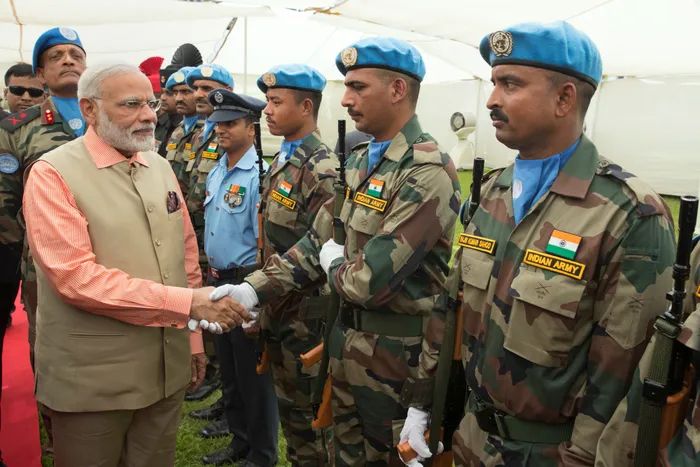The rise of exclusionary politics in India

Indian Prime Minister Narendra Modi greets members of the Indian contingent of United Nations Interim Force in Lebanon, during a visit to the World War I Indian Army cemetery, in the Israeli coastal city of Haifa, Israel, Thursday, July 6, 2017. (Jack Guez, Pool, via AP) Indian Prime Minister Narendra Modi greets members of the Indian contingent of United Nations Interim Force in Lebanon, during a visit to the World War I Indian Army cemetery, in the Israeli coastal city of Haifa, Israel, Thursday, July 6, 2017. (Jack Guez, Pool, via AP)
The politics of narrow, nationalist, parochial ideas is fast gaining ground in India. Under Indian Prime Minister Narendra Modi, the pseudo-fascist Hindu nationalist group the Rashtriya Swayamsevak Sangh (RSS) has gained unprecedented political clout.
Modi was, after all, a footsoldier of the RSS for decades, and his rise to power can largely be attributed to the mobilisation of the RSS behind Modi’s campaign, as well as his anti-corruption message. The convergence of a majoritarian religious ideology with big business catapulted Modi to power. With RSS branches in more than 50000 villages, the group forms the backbone of the ruling BJP party, and is considered its ideological parent.
For those unfamiliar with the ideological underpinnings of the RSS, it is a militant group that believes in the supremacy of Hindus, and is known to preach hate against Muslims and Christian minorities. The RSS advocates what has become known as Hindutva, or Hindu-ness, and is alleged to be dictating the policies of the Modi administration behind the scenes.
The group is notoriously secretive, with no existing register of its members, and communications carried out verbally. Many have likened some of its practices to fascism, with men marching in unison with wooden staffs, wearing khaki shorts, white shirts, and black caps. They perform a sideways salute to their saffron coloured flag, with a symbol that has been likened to a swastika at the centre.
It was an RSS activist, Nathuran Godse, who assassinated Mahatma Gandhi in 1948, and testified in court that he had consciously killed him. Godse was an outspoken advocate of Hindu nationalism, and felt Gandhi was working against the interests of Hindus. The slogan at the time among Hindu nationalists was “those who will work for Hindu interests will rule the country”.
The RSS has been banned three times in post-independence India - the first time after Gandhi was assassinated, the second by prime minister Indira Gandhi in 1975, and again in 1992 after the RSS demolished the Babri mosque in Ayodhya to build a Hindu temple.
Modi was introduced to the RSS at the age of 8, and by the age of 21 he was a full time worker for the group. It was the RSS that assigned him to the BJP in 1985, and propelled him forward, seeing him become the party’s general secretary in 2001. Key posts in the BJP have traditionally been manned by RSS Pracharaks, or propagandists, and with Modi’s rise to power, the RSS has gained a foothold in the corridors of power.
Modi has appointed people with strong RSS backgrounds in key government positions, and spearheaded an issue at the top of the RSS agenda - to strengthen the position of the BJP in north-east India in order to stop the conversion of Hindus to Christianity.
The umbilical ties that bind the RSS to the BJP, has meant that its chauvinistic agenda has gained momentum and become increasingly popularised across the country since 2014 with the BJP as the ruling party. With the calls of RSS figures for the lynching of people that eat beef in the name of Hindutva, the country has witnessed a spate of lynchings in recent months. Official figures put the number of lynchings at 17, although opposition politicians say that the number is as high as 50 in the past two months. A prominent RSS leader said recently: “Those who eat beef have no human rights.”
Such inflammatory rhetoric has led to the killing of innocent people, such as 15-year-old Junaid Khan who was stabbed to death on a train by men calling themselves cow vigilantes. Khan was returning home from buying clothes for Eid, when the mob shouted that he should go and live in Pakistan, before stabbing him to death.
There was no immediate condemnation of his killing from Modi or the central government. Other such cases involved a meat trader being beaten to death by cow vigilantes, for which a local BJP leader was arrested. These developments have left minorities in India feeling insecure. It took a significant amount of time and lobbying before Modi made a public statement that killing on the pretext of protecting cows was not acceptable.
Given India’s slide towards the politics of exclusion, it will take a broad platform of secular, progressive, anti-communal forces to forge a united front and engage in mass action if the current forces of Hindutva are to be marginalised. Over the previous decade of Congress Party rule, there was no strategy to check the rise of Hindu nationalism and lay a strong basis for social cohesion. Perhaps the forces of the left will now have to learn the lessons of history.
* Ebrahim is group foreign editor